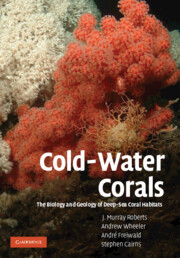4 - Reefs and mounds
Published online by Cambridge University Press: 23 December 2009
Summary
Even some zoologists and geologists perennially express surprise not only that corals exist in deep cold waters, but that in certain instances they create appreciable deposits of calcium carbonate, in the form of accumulations of their skeletal remains.
Coral banks occurring in deep water on the Blake Plateau Thomas R. Stetson, Donald F. Squires and Richard M. Pratt (1962)Cold-water coral reefs and coral carbonate mounds are morphological features formed through complex interactions between biological and geological processes under suitable hydrodynamic conditions. Such interactions are common in marine systems with biological activity having a profound effect on a number of sedimentological processes: from diatom stabilisation of mudflat surfaces, to the role of algae in carbonate grapestone formation and the development of deep-water bioherms. Marine organisms can strongly influence their sedimentary environments and where their activities are focused in one place, distinct biogeological structures may be formed. Such scenarios often involve enhanced sediment accumulation through substratum stabilisation and/or sediment trapping and usually benefit the organisms in question, for instance by giving them a preferential position from which to feed and isolating them from the effects of scouring bedload transport.
Such biogeological formations are not only common in the geological record, because they form persistent features, but also because such positive interactions are ubiquitous throughout Earth history.
- Type
- Chapter
- Information
- Cold-Water CoralsThe Biology and Geology of Deep-Sea Coral Habitats, pp. 108 - 141Publisher: Cambridge University PressPrint publication year: 2009



